Open data to track progress in the EU’s recycling targets
Key datasets and indicators for monitoring waste treatment
Recycling is a key element of the European Union’s waste management policy. It aims to contribute to the realisation of a circular economy that maximises the extraction of high-quality resources from waste. The European Green Deal, which serves as the blueprint for a modern, resource-efficient and competitive economy, prioritises the transition towards sustainable practices.
In pursuit of this goal, the waste framework directive serves as the primary legal framework for waste treatment and management in the EU. At the heart of EU waste management lies the waste hierarchy, consisting of five essential steps, as established by the waste framework directive.
This hierarchy provides a prioritised approach to waste management and disposal. Within this directive, waste prevention is emphasised as the preferred option, while landfilling is regarded as a measure of last resort. To ensure the well-being of both humans and the environment, the directive mandates that waste management activities must not endanger public health, harm natural ecosystems or cause nuisances such as noise or odours. It also emphasises the principle of the ‘polluter pays’ and introduces the concept of ‘extended producer responsibility’.
To comply with the objectives outlined in the waste framework directive, EU Member States are required to implement measures that address specific recycling targets within set time frames.
To progress towards a more sustainable future, the EU has set recycling targets to be achieved in the coming years. By 2025, in each Member State, the minimum weight of municipal waste that should be recycled or prepared for reuse must be increased to at least 55 %. Moreover, by 2030 and 2035, these minimum weights must further rise to 60 % and 65 % respectively.
Tracking recycling in the EU
The European Environment Agency (EEA) is an EU body that provides useful data about recycling, such as data on municipal or packaging waste. An interesting dataset to track is the one that shows recycling targets for municipal and packaging waste, with a breakdown available for different types of materials.
As defined by Eurostat, ‘municipal waste consists of waste collected by or on behalf of municipal authorities and disposed of through waste management systems. Municipal waste consists mainly of waste generated by households, although it also includes similar waste from sources such as shops, offices and public institutions’. Packaging waste, on the other hand, refers to the packaging of ‘products made of any materials of any nature to be used for the containment, protection, handling, delivery and presentation of goods, from raw materials to processed goods, from the producer to the user or the consumer’.
As shown by the following visualisation, the target recycling rate for municipal waste in Member States is set to 60 % and 65 % by 2035. Furthermore, by 2030, at least 55 % of plastics packaging, 60 % of aluminium packaging, 75 % of glass packaging, 80 % of ferrous metal packaging and 85 % of paper and cardboard packaging should be recycled.
According to Eurostat, the EU-27 countries produced 2 153 950 000 tonnes of waste in 2020. Of those, 19 030 000 tonnes were made of plastic, 17 850 000 of glass, 64 190 000 of ferrous metal and 43 490 000 of paper and cardboard. Even a few points increase in recycling means a very large amount of reused material that won’t go to a landfill.
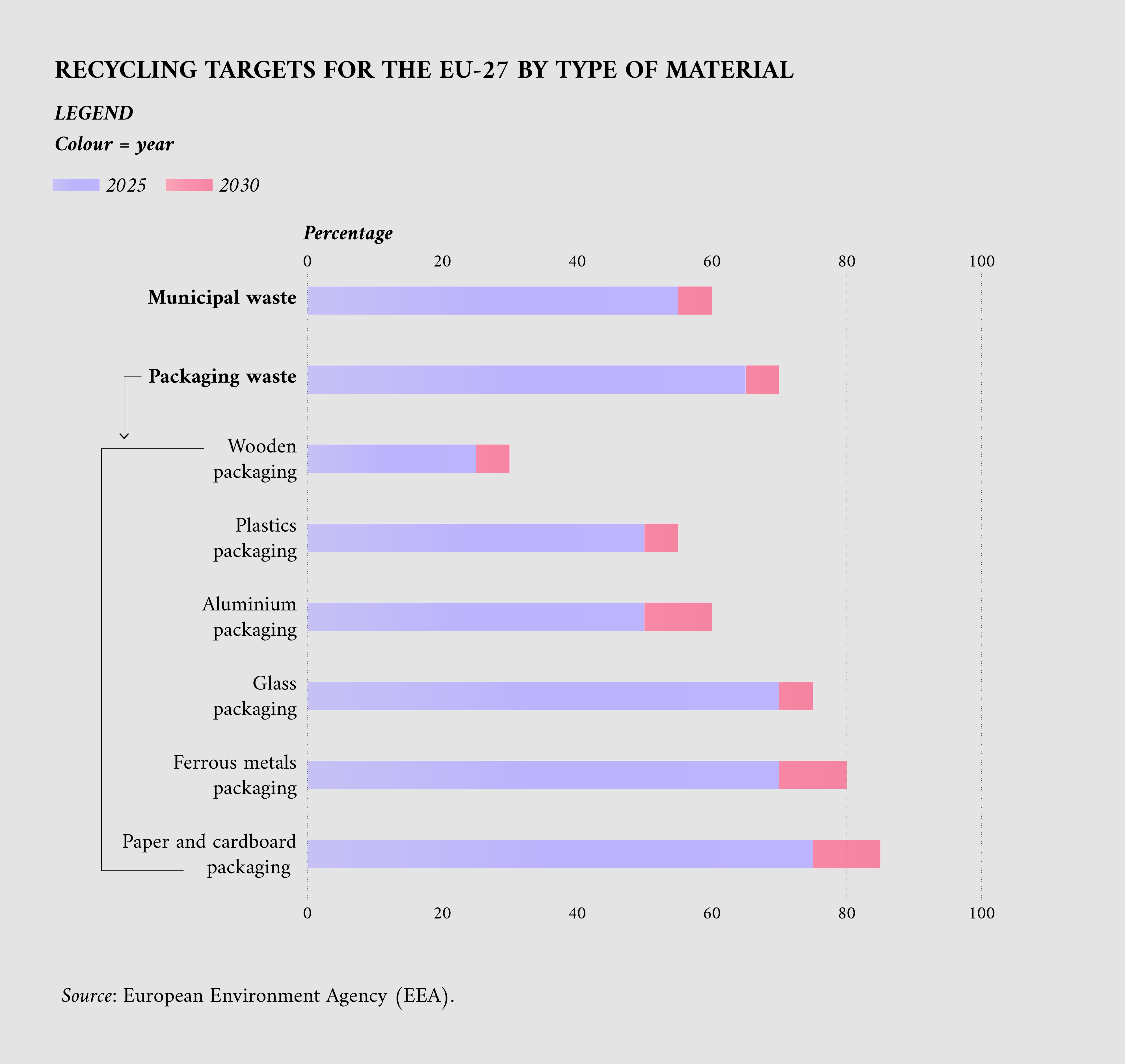
EU official bodies produce several datasets that make it possible to measure the progress towards those goals. Two important indicators to track, both available on Eurostat’s website, are the ones that measure the recycling rate of packaging and municipal waste in the EU and the EEA.
Generally speaking, the recycling rate experienced a significant growth in the last few years. Many countries, such as Belgium, Czechia, Estonia, Finland, Germany, Italy, Liechtenstein, Luxembourg, the Netherlands, Slovakia, Slovenia and Spain, have already reached or are very near the 2030 recycling target for packaging waste.
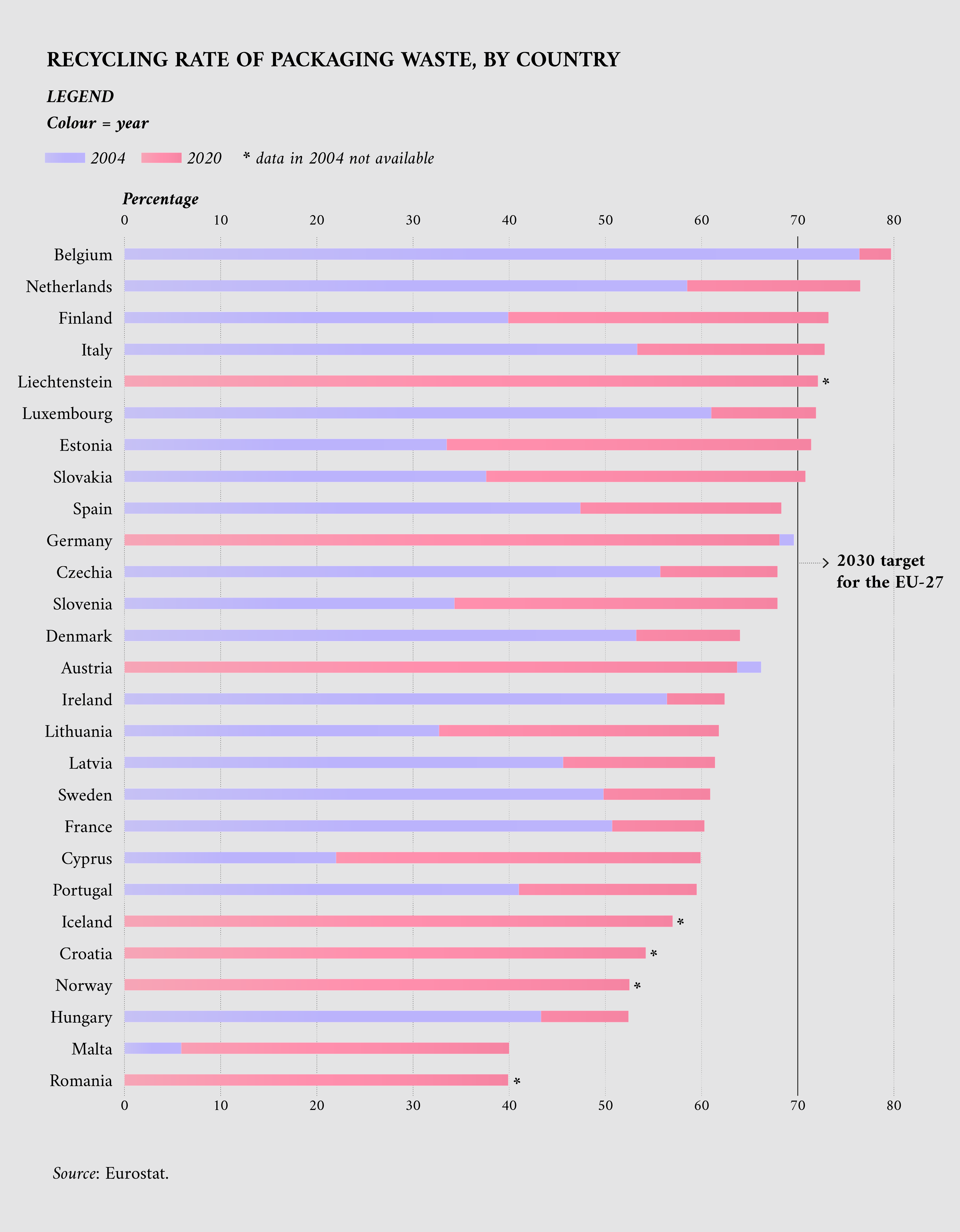
For municipal waste, the EU-27 recycling rate average almost doubled from 27.3 % in 2000 to 49.6 % in 2021. As the following visualisation shows, five Member States recycle more than half their waste: 71.1 % in Germany, 60 % in Slovenia, 57.8 % in the Netherlands, 55.3 % in Luxembourg and 53.3 % in Belgium. Slovenia’s case is particularly interesting. The country had a recycling rate of 6 % in 2000, but was able to increase it tenfold over the years and become the second-largest recycler in the EU. At the same time many other countries, especially in central and eastern Europe, managed to quickly grow their recycling share, and among them we find Czechia, Estonia, Latvia, Lithuania, Hungary, Poland and Slovakia.
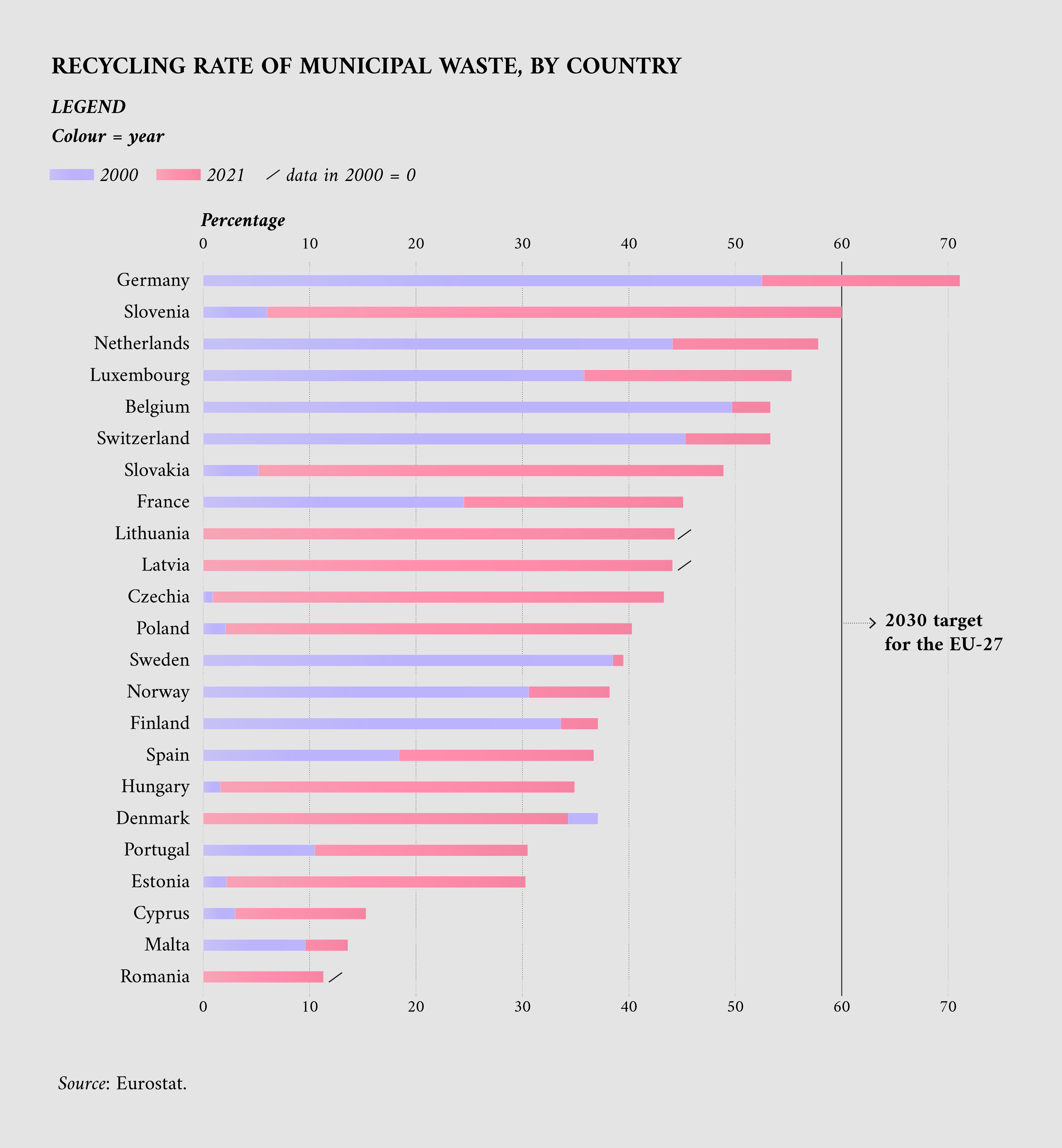
Recycling data on data.europa.eu
The data.europa.eu portal offers thousands of datasets concerning recycling. One of the most active contributors has been Slovenia, who provides over a hundred datasets that detail all kinds of information on recycling: data about the recovered or disposed quantity of waste, imports and exports of wastes in the whole country, the location of general and waste oil collectors in different municipalities, and so on.
For a high-level overview of recycling in Slovenia, a good starting point is a dataset that provides details on the amount of waste recycled, categorised by material type, from 2002 to 2021. As demonstrated in the following visualisation, during this period the amount of waste generated in Slovenia noticeably increased. However, recycling efforts also saw a substantial rise. A significant portion of this increase can be attributed to waste generated in construction and demolition as well as waste management facilities, where some of the waste is processed and recycled, and some becomes waste again.
As this EEA report highlights, despite all efforts in waste prevention and minimisation, part of the waste still requires treatment and safe disposal facilities. Waste management facilities are structures equipped for the collection, recovery or disposal of waste, and are responsible for preparing or processing it for recycling when possible.
Conversely, other sectors, such as wood processing, paper production and thermal processes, witnessed a significant decrease in the overall amount of waste produced. On the other hand, metal and plastic treatment, packaging and municipal waste experienced considerable growth in 2021 compared to 2002.
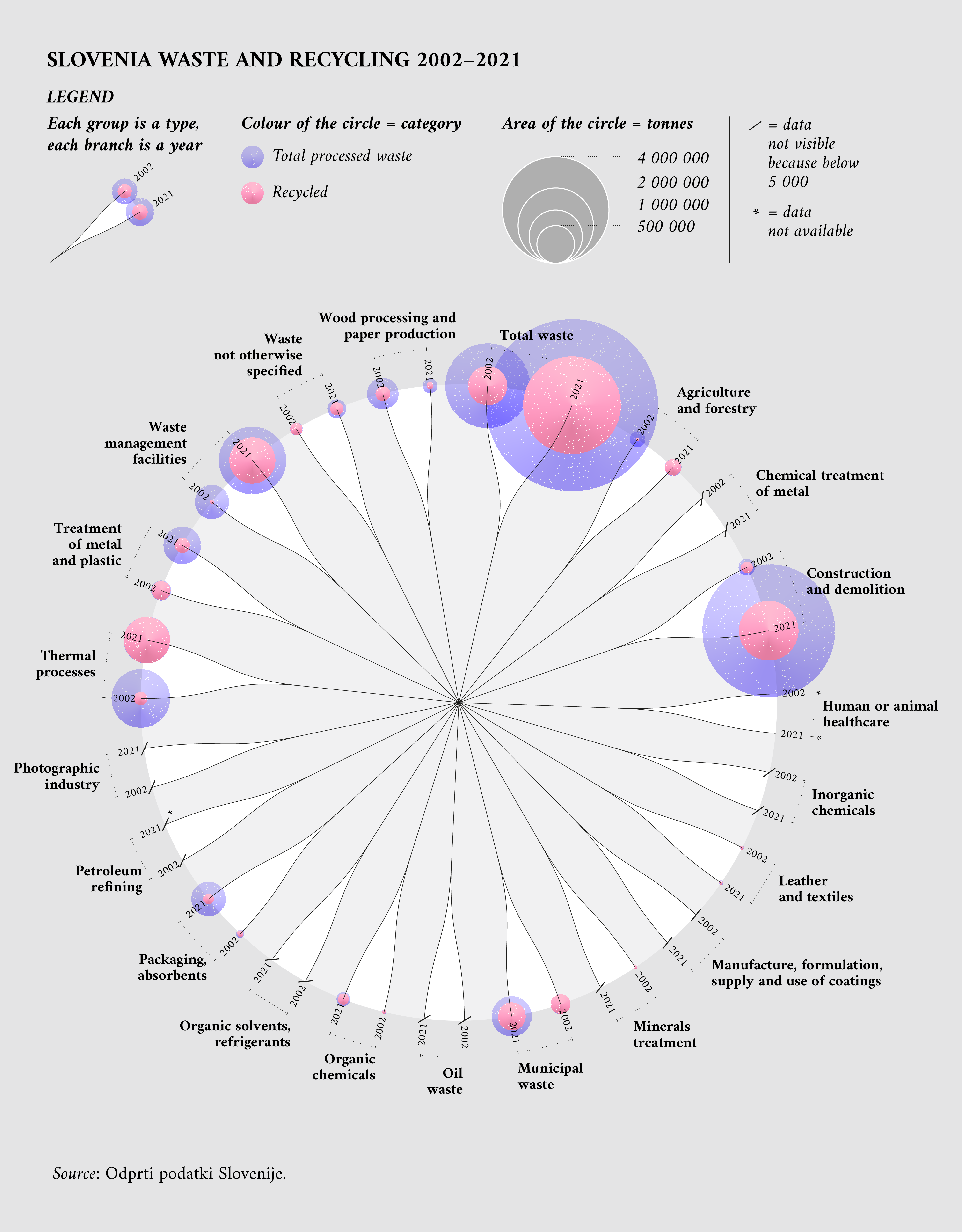
In addition to showing progress on a national level, open data can also be used on a local basis. By collating different datasets from the Slovenian open data portal, for example, it is possible to build a map of waste collectors and ‘ecological islands’ in different municipalities. Ecological islands are sites where citizens can drop off their waste, usually in different bins for the appropriate kind of material.
The following map shows the location of ecological islands in the cities of Sevnica and Radovljica, while the original datasets also provide other useful information pertaining to the ecological islands. According to the data, Radovljica has 38 ecological islands while Sevnica has 188. Both are small towns of roughly the same area located, respectively, in the north-western and in the south-eastern side of Slovenia. In 2020 they had about 6 000 and 4 500 inhabitants, respectively.
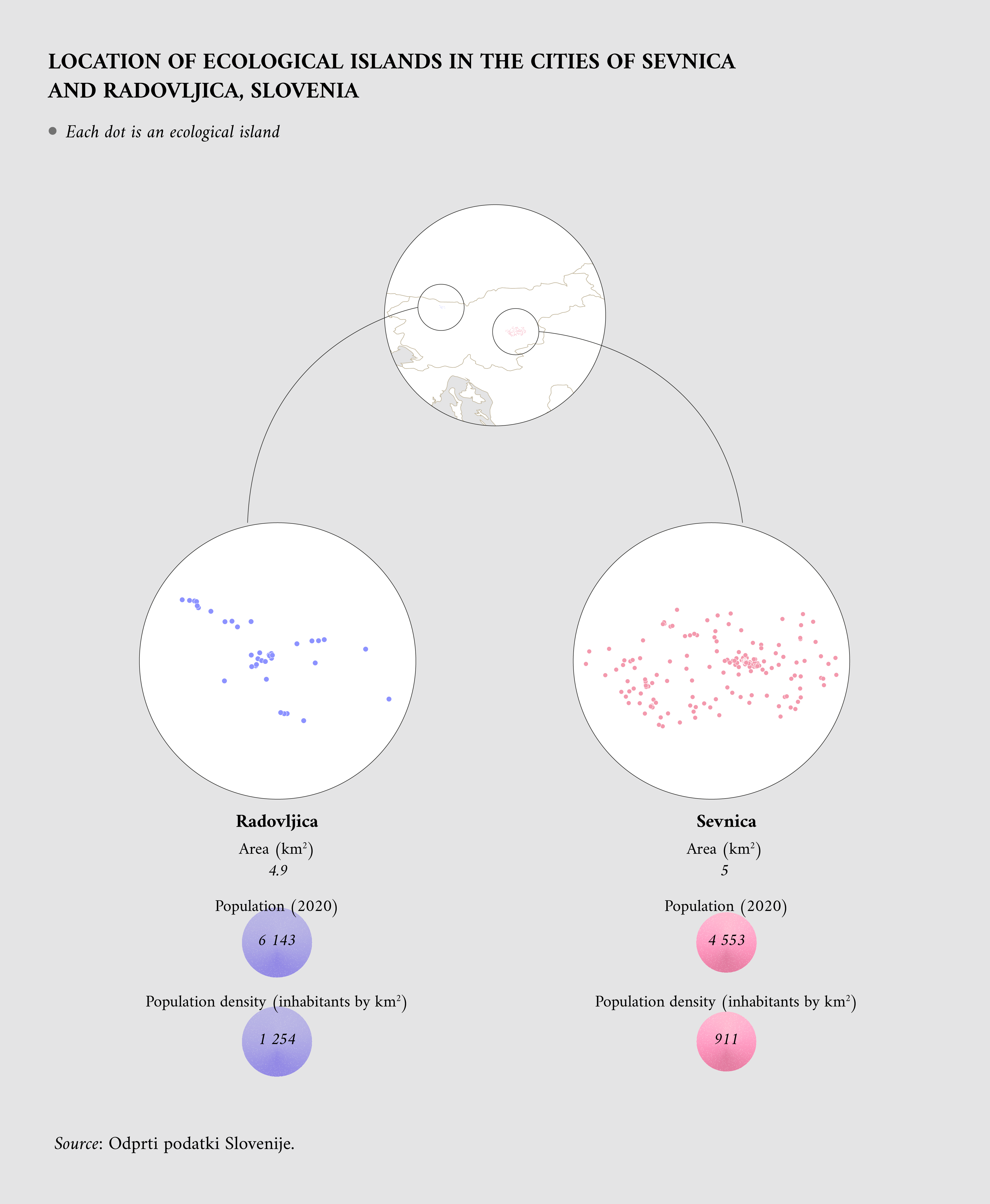
As this case study shows, open data is a valuable resource that extends its usefulness beyond high-level countrywide targets, such as achieving specific recycling goals. It also proves to be beneficial for citizens at the municipality level, facilitating easy access to relevant information, such as finding the nearest ecological island. By making data openly available, governments empower individuals to make informed decisions and actively participate in their local communities’ environmental initiatives. Citizens can conveniently locate nearby ecological islands, contributing to waste management efforts and reducing their carbon footprint.
METHOLODOGICAL NOTES
When this story was produced, 2021 data about the recycling rate of municipal waste from Eurostat was not yet available for the following countries: Bulgaria, Ireland, Greece, Italy and Austria. For packaging waste, data for the following countries was not available: Bulgaria, Greece, Croatia and Poland. In both cases, years were selected to provide the longest time series possible for most countries. Data from the data.europa.eu portal concerning recycling in Slovenia cannot be directly compared to other sources because a different classification of waste was used. To translate the waste categories from Slovenian the classification page of the Slovenian Statistical Office was used.
Download the data visualisations presented in this article and the data behind them.
Article by Davide Mancino
Data visualisations by Federica Fragapane
